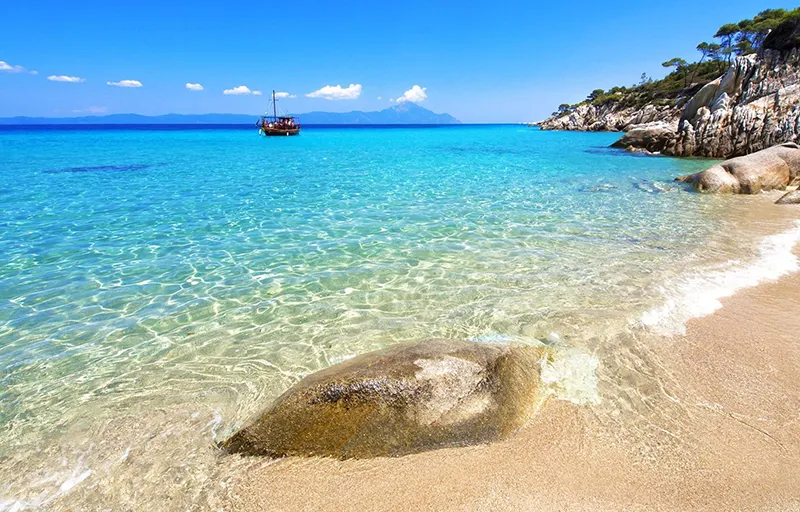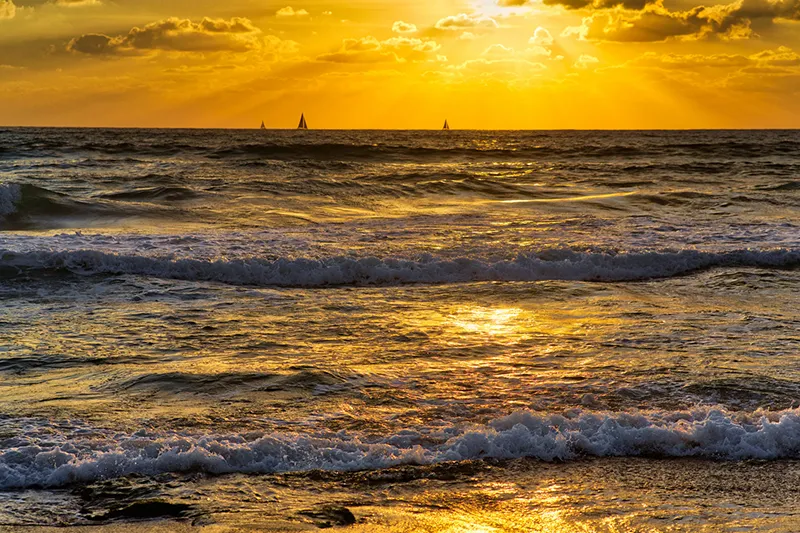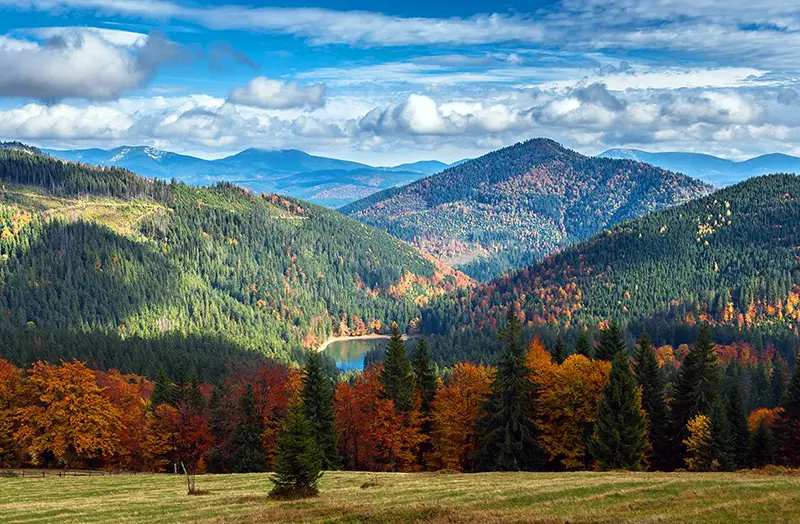The Aegean Sea is a part of the Mediterranean Sea located between Greece and Turkey. It is named after the ancient Greek region of Aegean. The sea is shaped as a narrow triangle extending north from the archipelagos of Crete and Rhodes to the coasts of Greece and Turkey. The Aegean Sea also washes some other Greek islands, such as Lesvos, Samos, and Kos.
The Aegean Sea is important historically because it is the birthplace of ancient Greek civilization. It was home to ancient Greek city-states such as Athens, Sparta, and Troy. The sea was also the theater of many historical events, including the mythological story of the Trojan War.
History
Civilization in the Aegean Islands developed long before the time of the legendary Odysseus. People lived and created in these areas for seven millennia B.C. Ancient Greek culture was shaped by many and varied influences. Between Athens and Smyrna (the Greek name for Izmir in Turkey) there were trade routes that connected Europe, Africa, and Asia. Ships not only transported goods, but also facilitated the exchange of traditions between different peoples. From this mixture of different cultural elements, new civilizations were born that perished because of wars or earthquakes. The Minoan civilization, which developed on the island of Crete, reached its peak in the second millennium B.C. and lasted until the fifteenth century B.C. It was named after the legendary King Minos of Crete. Historians connect its decline with the powerful eruption of the volcano on the island of Santorin (Tira) in the Cyclades archipelago, which caused catastrophic consequences in the entire region. The Cyclades had their own civilization in the third and third centuries B.C., influenced by the Minoan and Hellas civilizations that developed on the Greek mainland.
In the XV-XIII centuries Crete and Cyclades were conquered by the Aegean Sea. Crete and Cyclades were conquered by the Achaeans who settled on many islands in the Aegean Sea. This was the heyday of the Mycenaean civilization.
The Classical period of antiquity (V-IV centuries B.C.) greatly contributed to the development of philosophy, architecture and art, politics and education throughout the modern world. This is when all the ancient Greek legends and myths related to the Aegean Sea and its shores were born.
The lands around the Aegean Sea have seen turbulent periods in history – from the 4th century BC they were under Macedonian rule, in 146 BC they were conquered by the Romans, in the 4th century AD they were part of the Byzantine Empire. The Crusaders also came here. Part of the lands of what is now Greece and Turkey, particularly Rhodes, Halicarnassus (Bodrum), were seized by the Hospitallers (Knights of the Order of Malta). In Rhodes, in addition to the remnants of ancient architecture, there are excellent examples of medieval architecture of the Crusaders. The Aegean Sea became an arena of conflicts between Venice (which enjoyed the support of the Western European aristocracy) and the powerful Ottoman Empire, which conquered most of Greece in the 15th century. Greece finally gained independence, and since then most of the islands in the Aegean belong to Greece.
The Aegean was formed about 20,000 years ago by the sinking of the land mass (the Aegean Sea), of which the many islands on its surface are a part.
Myths
Associated with the name of the Aegean Sea is the famous myth of Theseus, who killed the Minotaur. Aegeus, king of Athens, was the hero’s father. He stipulated with his son, on his way to Crete, that in the case of a favorable outcome (victory over the beast) the black sails on the ship of “mortals,” prepared as food for the man-beast, would be replaced by white ones. Theseus defeated the Minotaur and thanks to Ariadne, who gave him the guiding thread, he got out of the labyrinth with his companions, but in the meantime he forgot to change the sails. Aegeus, seeing a ship with black sails in the distance, could not hold out in despair and threw himself over the cliff into the sea, which since then has been called the Aegean.
There is a myth connected with almost every island and coast of the Aegean. On the western shore of Asia Minor, the events of the Trojan War took place in the XII century, described in the “Iliad” by Homer, the waters were ploughed by the famous Odysseus in his endless voyage. On the island of Jura in Northern Sporades, the cunning Ulysses blinded Polyphemus, on Skyros Achilles lived and Theseus died, on Serifos Perseus grew up, near Samos Icarus fell into the sea, buried on Icaria, on the island of Cos Heracles carried out a massacre, on Delos, Leto gave birth to Apollo and Artemis; on Lemnos the unsightly Hephaestus was thrown down by his divine mother; here the Argonauts were stuck for two years in the company of the Amazons; and on Ios the great Homer himself was buried.
Of the two thousand islands in the Aegean, just over two hundred are inhabited. The fabulous islands have lost some of their charm over the past century due to massive deforestation. Despite this, the sea, the monuments of antiquity, the people and their picturesque white houses create an unforgettable atmosphere, so attractive to tourists. On the rocky slopes grow olives, grapes, figs and oleanders. Spring is the most suitable season to visit the Aegean Islands, as during this time they are covered with greenery, which burns out with the arrival of the summer heat.
The local climate is stable, but not to everyone’s taste four out of five days a very strong northeasterly wind blows, warm and dry. Typical of the Aegean Sea is the constant weak current (up to 1 km / h) in a counterclockwise direction: along the west coast to the south, along the east coast to the north. To the northeast, it is connected to the Black Sea through the Dardanelles and from there to the Marmara Sea through the Bosporus.
In the Aegean Sea, shipping has traditionally been developed, but the fishing industry is gradually declining due to the deterioration of the environmental situation. Sardines are mainly caught for production purposes, while other fish species are used more for tourists.
General Information
- The largest islands are Sporades, Cyclades, Crete, Rhodes, Evia and Lesvos. The area is often affected by low intensity earthquakes.
- The largest ports are Piraeus, Thessaloniki (Greece), Izmir (Turkey).
- Languages: Greek, Turkish.
- Religion: Orthodox Christians, Muslims.
- Area: 214,000 km2.
- Length: 610 km.
- Width: 300 km.
- Maximum depth: 3,543 km.
- Water salinity: 37-39%о.
Economy
- Tourism.
- Sea cargo transportations (numerous ports).
- Fishing.
- Industry: electrical engineering, shipbuilding, food industry.
- Agriculture: cultivation of grapes and olives.
Attractions
- Islands of Sporades and Cyclades.
- The Island of Crete.
- The West coast of Turkey (numerous monuments of antiquity).
- Mount Athos.
Fun Facts
- On the island of Mykonos there is a non-profit Aegean Sea Museum, which aims to preserve, display and study the history and traditions of Greek seafaring.
- The island of Evia, north of Athens, is one of the greenest and most fertile of the Aegean islands.
- On the island of Amorgos, the French filmmaker Luc Besson shot the movie “The Blue Abyss”.
- The island of Keos (Kea) was known for a special ritual custom – the suicide of old men: they held a last feast, put on wreaths and drank scurvy. Another fact is connected with the island: in 1916, the British liner Britannicus ran on a mine and sank near the island.
- The poetess Sappho lived and worked on the island of Lesvos in the 7th-7th centuries BC. Aristotle also lived here for some time.




